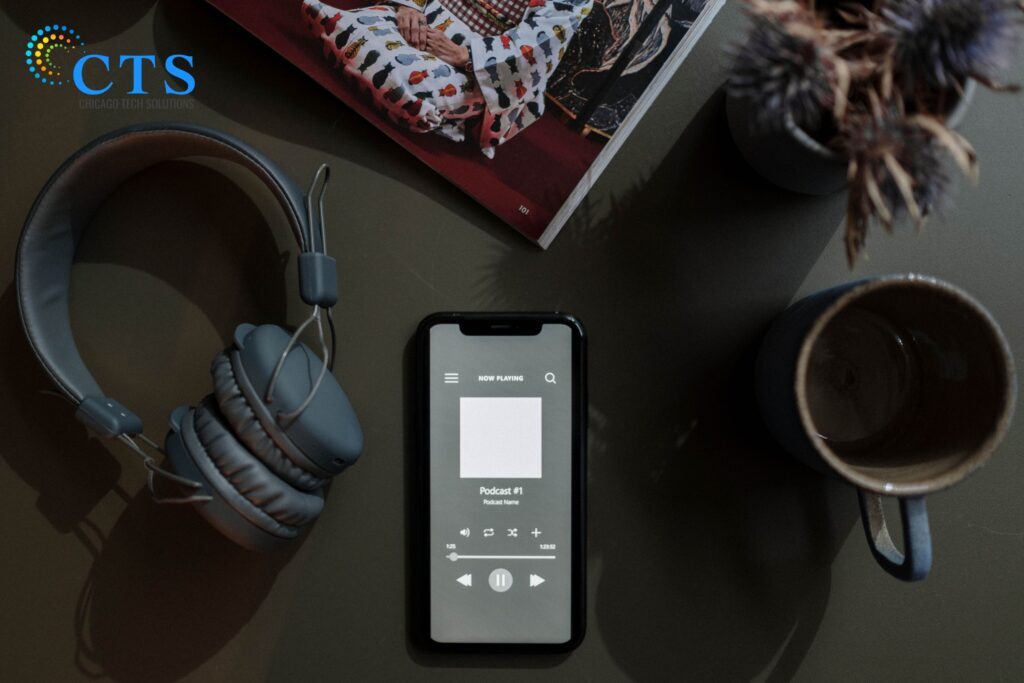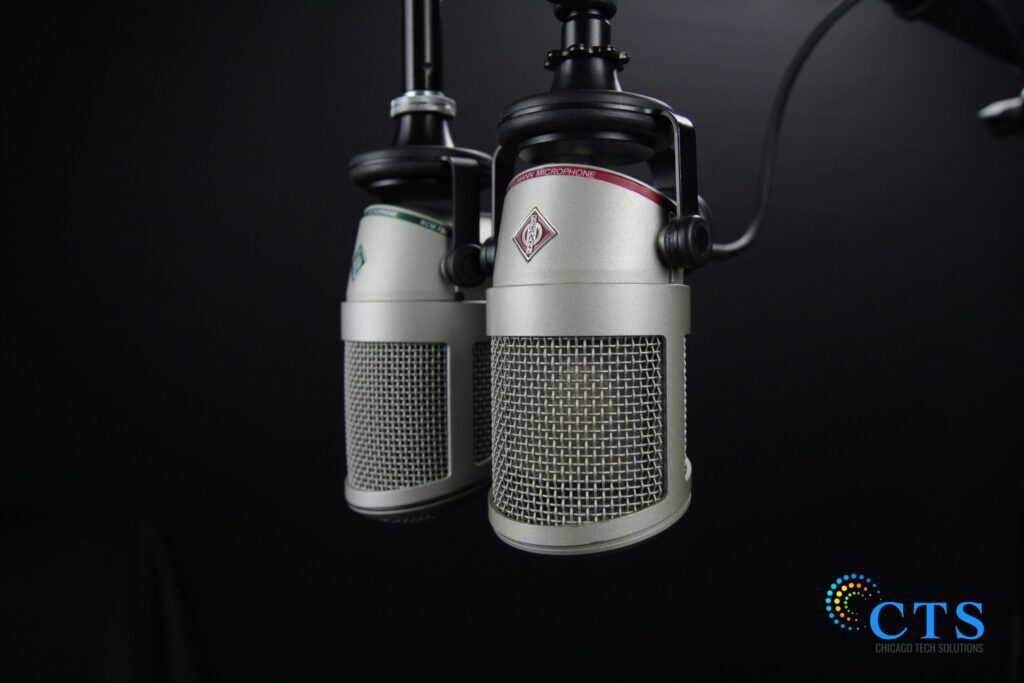Get ready to embark on an exciting adventure into the world of podcasting with Chicago Tech Solution. In this comprehensive blog, we’re here to guide you through the complete step-by-step process to start a podcast and monetize it like a pro. So grab your headphones, find a cozy spot, and let’s dive into the fascinating realm of podcasting!
Podcasting has taken the digital world by storm, offering a unique platform for sharing your thoughts, ideas, and stories with a global audience. But to start a podcast can be overwhelming, especially if you’re new to the game. That’s where we come in. Chicago Tech Solution is here to break down the entire process into simple, manageable steps, ensuring that you have all the tools and knowledge you need to launch your very own successful podcast.
In this blog, we’ll cover everything from choosing your podcast niche and selecting the right equipment to recording and editing your episodes, creating captivating content, and promoting your podcast to reach a wider audience. But we won’t stop there! We’ll also delve into the exciting world of monetization, exploring various strategies and opportunities to turn your passion for podcasting into a profitable venture. So, whether you’re a storyteller, a knowledge sharer, or an entrepreneur looking to expand your brand, this step-by-step guide is your ticket to podcasting success. Let’s dive in and unleash your podcasting potential like never before!
Step 1: Choose a Podcast Niche

If you’re thinking to start a podcast, the first and most important step is to choose a podcast niche. Your niche is the focus of your podcast, and it will determine the content you create and the audience you attract.
Choosing a podcast niche can be a daunting task, but it’s important to take the time to choose the right one. Here are some tips to help you choose the perfect podcast niche:
- Choose something you’re passionate about: Your podcast niche should be something you’re passionate about and enjoy talking about. This will ensure that you remain engaged and interested in the content you’re creating.
- Research popular niches: Look at what topics are popular in the podcast world and consider whether any of them align with your interests and passions.
- Consider your expertise: Do you have a particular area of expertise that you can share with your audience? This could be a great starting point for your podcast niche.
- Think about your audience: Who do you want to listen to your podcast? Consider the demographics and interests of your target audience and choose a niche that will appeal to them.
Once you’ve chosen your niche, make sure to refine it further. Think about what sets your podcast apart from others in the same niche, and make sure you have a clear and concise message for your listeners. Choosing the right niche is just the first step in starting a successful podcast, but it’s an important one that will set the foundation for your content and audience.
Step 2: Choose Your Podcast Format

Congratulations on taking the first step towards starting your own podcast! Now that you have decided on your niche, it’s time to think about your podcast format. The format you choose will set the tone and style for your entire podcast, so it’s important to choose the one that fits your niche and personality best.
There are several different formats to choose from, so let’s dive in and explore each one:
- Interview Format: In this format, you’ll invite guests onto your podcast and interview them about a specific topic or their experiences. This is a great way to bring a fresh perspective to your podcast and to showcase the expertise of others.
- Solo Format: This format involves recording your thoughts and ideas on a particular topic without any guests. This is perfect if you want to share your own opinions or expertise on a topic.
- Co-Hosted Format: This format involves hosting your podcast with one or more co-hosts. It can add a great dynamic to your show and can be a lot of fun to bounce ideas off of each other.
- Roundtable Discussion Format: This format involves inviting a group of people to discuss a specific topic. This can be a great way to bring different perspectives to the table and to have a lively and engaging discussion.
- Storytelling Format: This format involves telling a story or series of stories over the course of your podcast. This can be a great way to keep your listeners engaged and wanting to hear more.
Now that you have a better understanding of the different podcast formats available, it’s time to choose the one that best suits your niche and personality. Don’t be afraid to experiment and try out different formats until you find the one that works best for you. Good luck and happy podcasting!
Step 3: Select the Right Equipment

Once you have determined your podcast niche and format, it’s time to choose the right equipment for your podcast. The quality of your equipment plays a crucial role in the success of your podcast. Listeners want to hear high-quality audio that is clear and easy to understand.
Here are some of the essential pieces of equipment you will need to start a podcast:
- Microphone: A good quality microphone is a must-have for any podcast. There are many different types of microphones available on the market, so it’s important to choose one that suits your needs. Condenser microphones are ideal for recording in a studio, while dynamic microphones are better for recording in noisy environments.
- Audio Interface: To establish a link between your microphone and computer, an audio interface is a piece of equipment you can utilize.It also enhances the quality of the sound by converting analog signals into digital signals.
- Headphones: A good pair of headphones is essential for monitoring your audio while recording. This allows you to hear any background noise or other issues that may affect the quality of your recording.
- Pop Filter: A pop filter is a simple device that helps to reduce the sound of plosive consonants (like “p” and “b”) during recording.
- Recording Software: There are various software choices accessible for recording and modifying your podcast.
When selecting your equipment, it’s important to consider your budget and the quality of the equipment you can afford. While it may be tempting to go for the cheapest option, investing in high-quality equipment will ultimately pay off in the quality of your podcast.
Choosing the right equipment is a crucial step in starting a successful podcast. With a good quality microphone, audio interface, headphones, pop filter, and recording software, you will be well on your way to producing high-quality content that will keep your listeners coming back for more.
Step 4: Record and Edit Your Podcast
Now that you have your podcast format and equipment in place, it’s time to start recording your episodes. Below are some suggestions to assist you in commencing:
- Find a quiet space: Choose a quiet location to record your podcast, free from background noise and distractions. It could be a dedicated room or simply a corner of your bedroom.
- Use a script: While it’s not necessary to have a word-for-word script, having a general outline or talking points will help keep you on track and ensure that you cover all the topics you want to discuss.
- Test your equipment: Before you start recording, make sure your equipment is working properly. Record a test episode to check the sound quality and to make sure everything is set up correctly.
- Record in batches: Recording multiple episodes in one sitting can save you time and energy in the long run. Just make sure to take breaks and stretch your legs between recordings.
- Edit your episodes: Once you have recorded your episodes, it’s time to edit them. Editing can help you remove any mistakes or awkward pauses, and add any sound effects or music. There are many editing software options available, such as Audacity and Adobe Audition.
Remember, the quality of your content is important, but so is the quality of your audio. It’s worth investing in a good microphone and other equipment to ensure that your podcast sounds professional.
With these tips, you’re ready to record and edit your podcast. In the next step, we’ll discuss how to host and distribute your podcast for the world to hear.
Step 5: Publish and Promote Your Podcast

Congratulations! You’ve recorded your first podcast episode. Now, it’s time to share it with the world. In Step 5 of our Complete Step by Step Guide to Start a Podcast and Monetize it, we will guide you through the process of publishing and promoting your podcast.
Publishing Your Podcast:
The first step in publishing your podcast is to find a hosting platform for your audio files. Popular hosting platforms include Podbean, Libsyn, and Buzzsprout. Choose a hosting platform that fits your budget and provides you with the necessary tools to distribute your podcast.
Once you have a hosting platform, you can upload your audio files and add the necessary information for your podcast, such as the title, episode description, and cover art. It’s essential to optimize your episode description with relevant keywords, so your podcast can be found by listeners.
Promoting Your Podcast:
Promoting your podcast is a crucial step in growing your audience. You can start by sharing your podcast on your social media platforms and creating a website for your podcast. Social media platforms such as Facebook, Twitter, and Instagram can help you reach a broader audience and connect with your listeners.
Additionally, you can submit your podcast to various directories, such as Apple Podcasts, Google Podcasts, and Spotify, to make it more accessible to listeners. Encourage your listeners to leave reviews and ratings on these platforms, as positive reviews and ratings can help your podcast climb the charts and gain more visibility.
Finally, don’t be afraid to collaborate with other podcasters or reach out to influencers in your niche. Cross-promotion can help you reach a new audience and grow your listener base.
Publishing and promoting your podcast are crucial steps in building a successful podcast. By following the steps outlined in this guide, you’ll be well on your way to building an engaged listener base and monetizing your podcast.
Step 6: Monetize Your Podcast

Congratulations on successfully creating and publishing your podcast! Now it’s time to explore the different ways to monetize your content and turn your passion into a profitable venture. Here are some effective ways to monetize your podcast:
- Sponsorships: Many podcasters make money through sponsorships. You can partner with brands and companies related to your niche and promote their products or services in your podcast episodes. In return, you’ll receive a fee or commission for each sale or click generated through your podcast.
- Affiliate marketing: Similar to sponsorships, affiliate marketing involves promoting products or services to your audience, but instead of receiving a fee or commission, you earn a percentage of each sale made through your unique affiliate link.
- Merchandise Sales: If you have a loyal audience, you can create and sell merchandise related to your podcast, such as t-shirts, mugs, or stickers. This not only generates revenue but also helps build a community around your brand.
- Crowdfunding: Crowdfunding platforms like Patreon and Kickstarter allow fans to support their favorite content creators by making recurring donations or one-time contributions. In return, you can offer exclusive content or perks to your supporters.
- Premium content: You can create premium content, such as bonus episodes, behind-the-scenes footage, or access to exclusive interviews, and offer them to your listeners for a fee.
- Events and workshops: Hosting live events or workshops related to your podcast can be a great way to connect with your audience and generate revenue. You can charge a ticket fee or offer a paid VIP experience for exclusive access to you and other special guests.
Remember, it’s essential to provide value to your audience before attempting to monetize your podcast. Build a loyal following and establish yourself as an authority in your niche before introducing any monetization strategies. With dedication and hard work, you can turn your podcast into a sustainable source of income.
In conclusion, to start a podcast can be overwhelming, but it doesn’t have to be. Follow these six steps, and you’ll be on your way to producing a high-quality podcast that engages and inspires your audience. Remember, it takes time and effort to build an audience, but with persistence and consistency, you can achieve your podcasting goals. Good luck!
How can we help?
Chicago Tech Solution can help in several ways to support the process to monetize and start a podcast.
Firstly, they can provide guidance and expertise on choosing the right equipment, recording and editing software, and hosting platforms for your podcast. They can also help with the technical setup of your podcast, including configuring your audio interface, microphone, and other equipment.
In addition, Chicago Tech Solution can assist with promoting your podcast and building your audience through various digital marketing strategies, including social media advertising, email marketing, and search engine optimization.
Furthermore, Chicago Tech Solution can provide consultation on monetizing your podcast, such as through sponsorships, merchandise sales, and crowdfunding. They can also assist with the setup of payment processing and ecommerce platforms to help you monetize your podcast efficiently.
Chicago Tech Solution can offer a comprehensive range of services to help you start and monetize your podcast, from the technical setup to marketing and monetization strategies.
Frequently asked questions:
Q: How much money can I make from a podcast?
A: The amount of money you can make from a podcast varies widely and depends on several factors such as your audience size, the niche you’re in, and the advertisers you work with. Some podcasters make a few hundred dollars per episode, while others make thousands. It’s important to focus on creating quality content and building your audience before monetizing your podcast.
Q: How do I find sponsors for my podcast?
A: One way to find sponsors for your podcast is to join an ad network like AdvertiseCast or Podcorn, which connects podcasters with advertisers. You can also reach out to companies in your niche and pitch them on sponsoring your podcast. It’s important to have a clear understanding of your audience demographics and engagement metrics to attract potential sponsors.
Q: Can I monetize my podcast through merchandise sales?
A: Yes, many podcasters monetize their shows through merchandise sales such as t-shirts, mugs, and other branded items. You can set up an online store and promote your merchandise on your podcast and social media channels.
Q: Do I need a large audience to monetize my podcast?
A: While having a larger audience can certainly increase your earning potential, it’s not always necessary to have a massive following to monetize your podcast. Some monetization strategies, such as merchandise sales and affiliate marketing, can be effective with a smaller audience. It’s important to focus on creating quality content and building a loyal fan base, regardless of your audience size.
Q: Should I charge for access to my podcast?
A: While some podcasters charge for access to their content, it’s not a common monetization strategy. Most podcasts are available for free and rely on advertising, merchandise sales, and other revenue streams to generate income. However, there are some podcasters who successfully use a subscription model, especially in niche markets where listeners are willing to pay for specialized content.
Q: How can I measure the success of my podcast?
A: The success of your podcast can be measured in several ways, including audience size, engagement metrics such as downloads and listens, social media engagement, and revenue generated. It’s important to set goals and track your progress over time to continually improve and grow your show.
Chicago Tech Solution can help with all aspects of starting and monetizing a podcast, from equipment selection and recording to publishing and promotion. We can also provide guidance on monetization strategies and help you build a loyal audience. Contact us today to learn more!
Conclusion:
You’ve reached the end of our complete step-by-step guide to start a podcast and monetize it with Chicago Tech Solution. We hope this blog has ignited your passion and equipped you with the knowledge and strategies to launch a successful and profitable podcast.
Remember, podcasting is not just about sharing your voice; it’s about building a community, connecting with your audience, and leaving a lasting impact. Throughout this guide, we’ve emphasized the importance of creativity, engagement, and promotion. By implementing the strategies and techniques we’ve discussed, you have the power to create a podcast that stands out from the crowd and captivates listeners far and wide.
Now that you’ve laid the foundation, it’s time to put your newfound knowledge into action. Take the leap, hit that record button, and share your unique voice with the world. Experiment, learn, and adapt along the way. Embrace the journey, as podcasting is a dynamic and ever-evolving medium.
As you continue on this podcasting adventure, remember that success comes not only from the quality of your content but also from your dedication, consistency, and ability to connect with your audience. Utilize the monetization strategies we’ve discussed to turn your passion project into a revenue-generating enterprise.
So, go forth and conquer the podcasting landscape. Chicago Tech Solution is here cheering you on every step of the way. Embrace your creativity, engage your audience, and let your voice be heard. It’s time to unleash your podcasting potential and make your mark in the exciting world of podcasting. Good luck, and happy podcasting!


